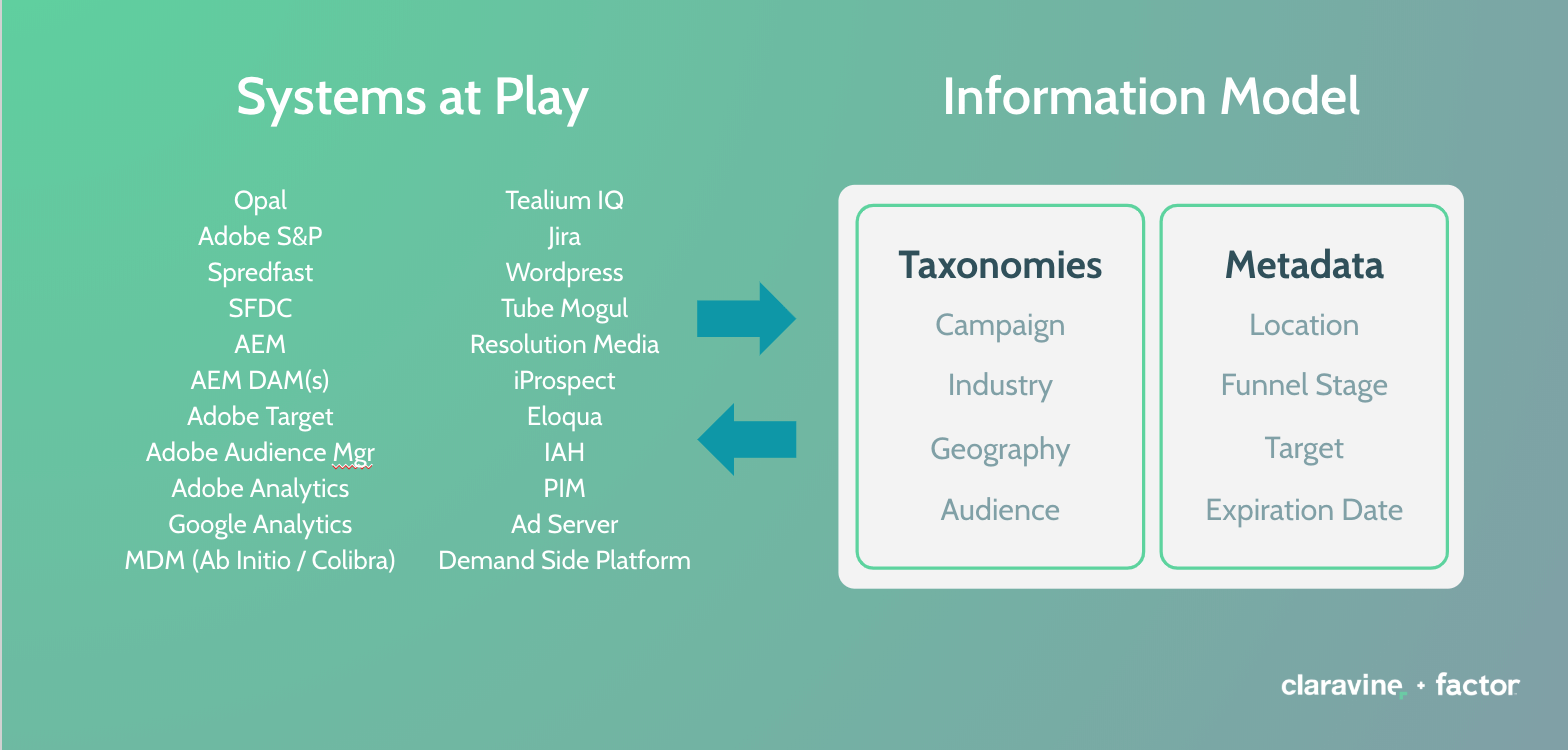Why you need an enterprise marketing taxonomy [and how to build one]
In college, I volunteered in a cancer research lab. Preparing the plates, centrifuging cells, diluting treatment, pipetting into hundreds of plate wells – cell culture was a long, painstaking process.
One day I labeled the plate covers with the wrong marker. In the steamy incubator, my descriptions of treatment type, volume, and cell count smudged and bled. Because I was uncareful with my labeling, key differences between the plates were now indecipherable. In the end, I wasted materials and time, and all my data was lost.

Enterprise marketing organizations differ in many ways from a university cancer research lab, but both rely on taxonomy. At a very basic level, the taxonomy described in a marketing context is a way to group and organize data. Taxonomies might also be referred to as schemas. Typically taxonomies are created by marketing organizations to give end-users (marketers) a structure to how they describe assets, for example, a landing page, piece of creative or content. They’re also created to help teams apply these descriptions – otherwise known as metadata tags – consistently. Like the smudged covers in my old lab, data that are collected without consistent taxonomy is difficult to decipher, creating analysis and data retrieval issues across an organization.
Although creating an enterprise-level marketing or media taxonomy may not seem like the most exciting task, it’s the first step to enabling your organization to create consistent data across systems, teams, and marketing activities. A unified taxonomy overlay for all lines of business will allow you to define core marketing concepts, optimize the use of content and metadata and execute on a marketing strategy anchored in robust data use.
We dive deeper into why organizations need a unified marketing/media taxonomy, share five ways to determine when an organization needs one, and provide the first steps to start building below.
Why organizations need an enterprise marketing taxonomy

An Enterprise-level Taxonomy is the scaffolding of the entire marketing ecosystem – a structured framework that teams on multiple levels and business units of your organization can choose to rely on when they track, structure, manipulate, or create metadata.
This scaffolding supports teams across all lines of business by helping them create consistent metadata classifications. Whether you work on the campaign execution side or manage a CMS, a taxonomy describes important classifications such as campaign names, region, or product line with the same structure, so data from different areas of the business can be compared downstream.
Multiple taxonomy implementations and no communication

Your organization may have several taxonomy implementations managed and used by different teams and systems. The individual groups may choose to comply and create consistent metadata in their systems, but what happens when the data is combined across the org? The structures and naming conventions still differ, and the systems and teams creating the data don’t communicate. A single taxonomy across all systems and users will simplify data collection and analysis.
Impact on Marketing Campaigns and Experiences
Marketing perspective: when a campaign is run, every aspect that involves data needs to be consistent. This is especially challenging after cross-channel campaigns. When data from multiple marketing solutions lack consistency, there’s no way to account for all campaign elements, compare experiences, or assess the involvement of a collection of experiences that drive conversion.
Impact on attribution/ROI:
- Incomplete execution reports
- Loss of trust in analytics
- Misassigned budget
Experience perspective: An experience involves products, creative, marketing channels, tactics, audiences, segments, offers, and a host of other elements. All of this comes together in the creation of an experience, but if the way you describe each experience is different, you can’t compare them.
Impact on content strategy and management:
- Lack of digital assets utilization
- Missing metadata tags for classification and use
- Confusing Site navigation
- Partial data for personalization
Ultimately, an enterprise marketing taxonomy is the first step to unifying data formats. This will make analytics faster and more accurate and content easier to find and use across the organization.
Five signs your marketing organization needs a shared and solid taxonomy
The short answer to the question ‘which organizations need an enterprise-wide marketing taxonomy’ is: any multi-business-unit organization that cares about analyzing the performance of experiences, campaigns, and content or wants to use the full scope of their metadata.
That being said, it may be harder to notice if you’re having taxonomy-related issues internally. Here are five ‘symptoms’ of a taxonomy-deprived enterprise to help you make the diagnosis:
1. When information is out of sync in different systems
When analysts and data scientists attempt to produce competitive analysis or compare how different content is performing, their job becomes very difficult if the data isn’t standardized. When naming and structure for placements, campaigns, assets, or channels, varies across platforms, creating reports quickly becomes a ‘comparing apples to oranges’ situation. If this is your experience, it’s a big red flag your organization needs one singular taxonomy across business units so your analytics teams can compare equivalent forms of metadata.
2. When redundant information appears in your data set
This happens when two similar or related systems of records have different schemas. For example, if an organization had a content taxonomy for a content management system (CMS) and another taxonomy in its digital asset management (DAM) platform. Those two are closely related and there is an overlap of content (and content metadata), but the separate naming system creates a disconnect between the data sets.
3. When your user starts experiencing problems
When you lack a unified taxonomy across marketing systems and business users, your personalized content (and in relation, customer satisfaction) is hindered too. Improper tagging or naming of content can affect the user’s experience: information in the wrong place at the wrong time for the wrong user.
4. When you observe problems with the search experience
Search is often an indicator of a deeper information problem. If you think you need a new search appliance for enterprise search, it might actually be a disconnection in the information layer.
5. When you see downstream issues in Analytics Platforms
For many brands, an early indicator of the need for a standardized taxonomy lives in their analytics platform.
- Analysts see tracking codes come through that aren’t associated with the proper channel or campaign. Making sense of these codes is a huge time suck for analytics teams before they can start their analysis.
- Marketers are impacted by classification when incomplete tracking negatively impacts their campaign attribution.
Get started building an enterprise marketing taxonomy
After you realize the importance of a unified marketing taxonomy and that your organization needs one, building it out can be daunting. Here are a couple of tips to get started:
Map it out
Our friends at Factor helped a mutual customer create a shared marketing taxonomy, and they started by plotting out the marketing systems. When you create your map, list the taxonomies that are being used by or managed in each marketing solution. A big part of this will be organizing key stakeholders in each line of business. Ask them about the information they’re managing for the business, and where they’re managing it. Grassroots participation will help later on when you start to implement the unified taxonomy. In the example above, the team created a central definition of core concepts like “Campaign” to standardized definitions across the enterprise.
Set a realistic timeline
Defining out the initial taxonomy depends on the complexity of your organization. A core definition of critical information assets can be created in 6-18 weeks. Note: a lot of information that you need has already been created by managers in different teams. Usually, this information will be stored in spreadsheets. Be efficient; a lot of mapping doesn’t have to be taxonomy creation as much as alignment. Dedication to taxonomy creation, and moving on to implementation, is a long-term project. In addition to the stakeholder interviews, see if your organization has a taxonomy or data management team already in place to support your efforts.
What Next?
Applying a unified taxonomy across a marketing ecosystem is the first key step to helping your organization create and optimize its data. Done consistently, this data will drive improved customer experience and social media, paid search and content marketing (any form of digital marketing really), create operational efficiencies and allow you to analyze how your business is performing with confidence.
While taxonomy specialists and data science teams may create a unified taxonomy, and teams from each line of your business may try their best to adhere to it, ensuring that everything is defined and validated correctly is extremely difficult. This is especially true for many enterprise companies where hundreds of people contribute to and create campaigns to promote content.
As you create your unified taxonomy, make sure you ask yourself this next essential question: how will I make this taxonomy accessible to business users and drive the data quality you’re hoping to achieve?
If you’re ready to learn more about how Claravine helps, get started here.





